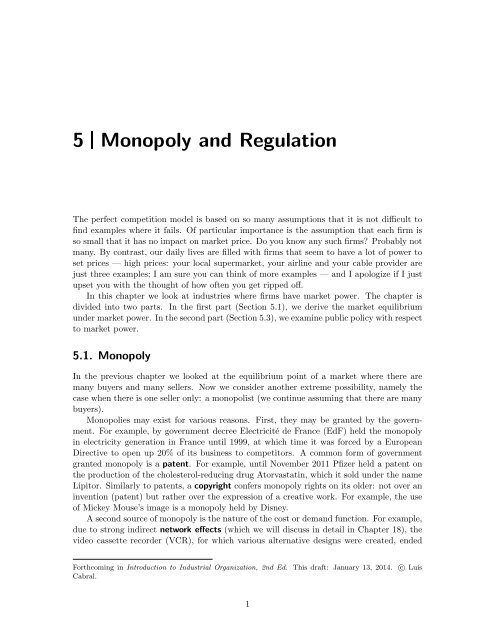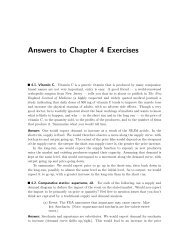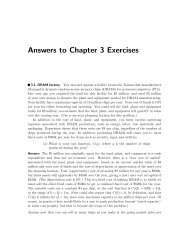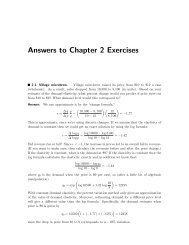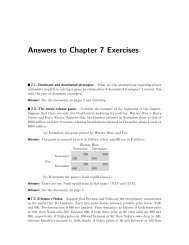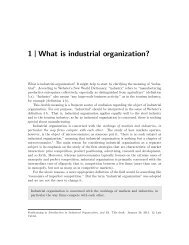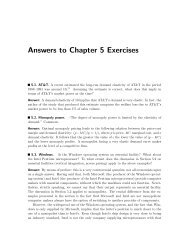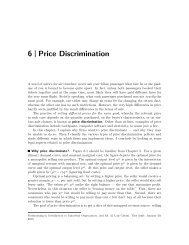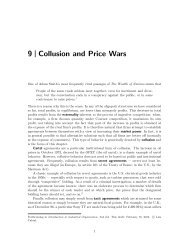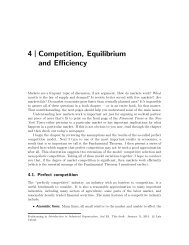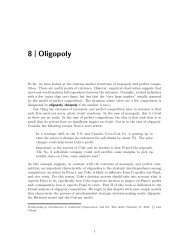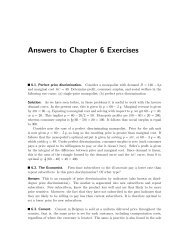5 Monopoly and Regulation - Luiscabral.net
5 Monopoly and Regulation - Luiscabral.net
5 Monopoly and Regulation - Luiscabral.net
Create successful ePaper yourself
Turn your PDF publications into a flip-book with our unique Google optimized e-Paper software.
5 <strong>Monopoly</strong> <strong>and</strong> <strong>Regulation</strong>The perfect competition model is based on so many assumptions that it is not difficult tofind examples where it fails. Of particular importance is the assumption that each firm isso small that it has no impact on market price. Do you know any such firms? Probably notmany. By contrast, our daily lives are filled with firms that seem to have a lot of power toset prices — high prices: your local supermarket, your airline <strong>and</strong> your cable provider arejust three examples; I am sure you can think of more examples — <strong>and</strong> I apologize if I justupset you with the thought of how often you get ripped off.In this chapter we look at industries where firms have market power. The chapter isdivided into two parts. In the first part (Section 5.1), we derive the market equilibriumunder market power. In the second part (Section 5.3), we examine public policy with respectto market power.5.1. <strong>Monopoly</strong>In the previous chapter we looked at the equilibrium point of a market where there aremany buyers <strong>and</strong> many sellers. Now we consider another extreme possibility, namely thecase when there is one seller only: a monopolist (we continue assuming that there are manybuyers).Monopolies may exist for various reasons. First, they may be granted by the government.For example, by government decree Electricité de France (EdF) held the monopolyin electricity generation in France until 1999, at which time it was forced by a EuropeanDirective to open up 20% of its business to competitors. A common form of governmentgranted monopoly is a patent. For example, until November 2011 Pfizer held a patent onthe production of the cholesterol-reducing drug Atorvastatin, which it sold under the nameLipitor. Similarly to patents, a copyright confers monopoly rights on its older: not over aninvention (patent) but rather over the expression of a creative work. For example, the useof Mickey Mouse’s image is a monopoly held by Disney.A second source of monopoly is the nature of the cost or dem<strong>and</strong> function. For example,due to strong indirect <strong>net</strong>work effects (which we will discuss in detail in Chapter 18), thevideo cassette recorder (VCR), for which various alternative designs were created, endedForthcoming in Introduction to Industrial Organization, 2nd Ed. This draft: January 13, 2014.Cabral.c○ Luís1
Figure 5.1Competitive <strong>and</strong> monopoly market equilibriappp CAB..........SDqp MAB.............CMRMCDqq Cq Mup in a de facto monopoly in terms of design (with VHS beating Betamax <strong>and</strong> otheralternatives).Frequently, a monopoly or near monopoly position results from various factors. Considerfor example the case of Intel. One reason for its success is that, over the years, it has ledthe industry in terms of product quality <strong>and</strong> efficient production (cf Chapter 17). It alsohelps that the set up costs required to create a production facility (a fab) are so high thatit would be difficult for an alternative company to rival Intel in size; that is, economies ofscale may play a role here (cf Chapters 3, 11). AMD is indeed a rival to Intel, but of muchsmaller size. In fact, some might argue that one of the reasons why AMD does not grow tobecome a closer competitor to Intel is to be found in Intel’s aggressive pricing strategies (cfChapter 13).The competitive <strong>and</strong> monopoly equilibria are contrasted in Figure 5.1. Suppose thereare two industries with the same dem<strong>and</strong> <strong>and</strong> market marginal cost curve. The differencebetween the two industries is that, in the first one (left) there are many small sellers, sothat the market is competitive; whereas in the second one (right) there is only one seller(monopolist).Under perfect competition, equilibrium price is determined by the intersection of thedem<strong>and</strong> <strong>and</strong> supply curves. Since the (inverse) dem<strong>and</strong> curve measures consumer willingnessto pay <strong>and</strong> the (inverse) supply curve measures marginal cost, the equilibrium point is thepoint at which willingness to pay is just equal to marginal cost. All trades in a competitivemarket (points to the left of q C ) are such that willingness to pay is greater than marginalcost; <strong>and</strong> there is no trade such that willingness to pay is higher than marginal cost thatdoes not take place. This is the essence of the Fundamental Theorem: all efficient tradestake place.Not so under monopoly. As can be seen from the right panel in Figure 5.1, equilibriumoutput under monopoly, q M , is lower than the efficient level, q C . In other words, all tradescorresponding to q M < q < q C fail to take place under monopoly. These trades would beefficient, that is, the buyer willingness to pay is greater than marginal cost. High airfares, forexample, mean that there are potential fliers who refrain from buying tickets even thoughthe cost of carrying them as passengers would be low. From a social point of view, it wouldbe efficient to fly many of these potential travelers: although the value they derive fromflying is lower than price (hence they don’t fly), that value is greater than the cost of flying(which is much lower than price).2
Table 5.1Long-distance telephone rates: AT&T, MCI <strong>and</strong> Sprint. 1Date ratechangedAT&T MCI SprintNewrateMonthsafterNewrateMonthsafterNewrateJanuary 87 .298 2 .289 2 .289January 88 .265 2 .256 2 .259January 89 .254 0 .244 0 .250January 90 .233 1 .223 1 .228January 91 .228 1 .222 5 .228July 91 .227 5 .223 1 .227January 92 .228 0 .224 2 .228June 92 .227 0 .225 5 .227February 93 .228 1 .225 2 .228August 93 .229September 93 .235 0 .234 1 .235January 94 .256 0 .255 0 .256just below those of the former monopolist. bSuppose that consumers choose the firm offering the lowest price <strong>and</strong> that the smallcarriers are capacity constrained, having a total capacity of K. This situation is depictedin Figure 5.2. Whichever price AT&T sets (above marginal cost), the small carriers will seta slightly smaller price <strong>and</strong> sell up to capacity. In practice, this implies that AT&T is facedwith the residual dem<strong>and</strong> D R , obtained from market dem<strong>and</strong> D by moving it K units tothe left, where K is the total capacity of the small competitors.Given the residual dem<strong>and</strong> D R , AT&T’s optimal price is derived in the usual way, byequating marginal revenue to marginal cost (MC ). This results in an optimal price p D <strong>and</strong>output q D . Notice that, so long as K is small, p D is close to p M , the monopoly price. Thissuggests that a dominant firm behaves in a way that is similar to a monopolist.In reality, things are a bit more complicated. Long-distance telecommunications is nota homogeneous product, or at least is not perceived as such by consumers. In fact, AT&T’sadvantage resulted primarily from a large base of loyal consumers who perceived AT&T’sservice as superior. This caveat notwithst<strong>and</strong>ing, the above model illustrates the idea thatThe monopoly model provides a good approximation to the behavior of dominant firms.<strong>Monopoly</strong> <strong>and</strong> monopoly power. Are there any monopolies? In the beginning of thechapter, I suggested the example of utilities (electricity, telephone, etc.). But most of thesehave been privatized, deregulated <strong>and</strong>/or open to competition in most Western countries,so that it seems more <strong>and</strong> more difficult to find an example of a pure monopoly. Or is it?Consider the case of Apple. Apple is the sole manufacturer of the Apple MacIntosh lineb. MCI changed its rates in the same month as AT&T in 5 out of 12 price changes. Sprint set the exactsame rates as AT&T from 1991 to 1994 (although it reacted to the latter’s changes with some lag).4
Figure 5.2Dominant-firm optimal pricepDp Mq Dq Mp D... .... ... ... .... ... ... .... ... ... .... ... ... .... ... ... .... ... ...................... .... .... ... .... .... ... .... .... . . .... .... ... .... .... ... ................D RMC........................................................ ........................................................Kqof personal computers. c That is, Apple is the monopoly supplier of the MacIntosh PC. Butcalling Apple a monopolist would be an artifact of a very contrived market definition. Itwould probably make more sense to talk about the market for personal computers, in whichcase a host of Windows-based computers should be included, leaving Apple with a modest10% or so market share.Simplistic as it might be, this example illustrates the point that defining monopoly basedon a market share calculation is bound to run into problems of market definition. Differentmarket definitions lead to potentially very different market shares. But why should weattach so much importance to market share when assessing a monopoly? Consider the twographs in Figure 5.3. In both cases we have, by assumption, a monopoly, that is, a firmwith a 100% market share. However, the degree of monopoly power, defined as the abilityto sell at a price substantially above cost, is much lower in the right-h<strong>and</strong> side case, thecase when dem<strong>and</strong> is more elastic. The general point is thatThe degree of monopoly power is inversely related to the dem<strong>and</strong> elasticity faced bythe seller.This definition of monopoly power seems more sensible than the one based on market share.For instance, suppose that the firm on the left-h<strong>and</strong> side of Figure 5.3 comm<strong>and</strong>s a marketshare of 90%, whereas the one on the right-h<strong>and</strong> side is a pure monopoly (100% marketshare). Even though, in terms of market share, the firm on the right is more of a monopoly,in terms of monopoly power the firm on the left seems more of a monopoly.The value of dem<strong>and</strong> elasticity depends on many factors, some static, some dynamic.This makes it difficult to judge the extent of monopoly power in actual situations. Take forexample Microsoft in the market for operating systems. In terms of market share, there isno question that Microsoft is a near monopolist (a dominant firm). But does it truly havemonopoly power? Box 5.1 addresses this question in greater detail.c. For a while, Apple allowed other firms to manufacture the MacInstosh — or “Mac clones” —, butthis is currently not the case.5
Figure 5.3Dem<strong>and</strong> elasticity <strong>and</strong> market powerppp ∗Dp ∗D... ... .... ... ... .... ... ... ... ................. ... .... ... ... ... ... ... ... ... ... .... ... .... ... ... ... ... ... ... .... ... .... . .......MCqMCqq ∗q ∗5.2. Competition policy <strong>and</strong> antitrustIn Chapter 4 we established that, in perfectly competitive industries, the market equilibriumis efficient. Unfortunately, there is no such thing as a perfectly competitive market.One reason why perfect competition fails is the presence of externalities, a possibility weconsidered in Chapter 4. However, the assumption that most obviously fails in many realworldmarkets is the assumption that there is a very large number of firms, so that each ofthem is too small to influence market price.In the previous section, we considered the opposite extreme in terms of market structure:monopoly (<strong>and</strong> its close relative, dominant firm). In this section, I provide an introductionto the public policy instruments that address market failure due to monopoly power. Thesection’s title, “competition policy <strong>and</strong> antitrust,” suggests that there are two types of suchpolicy. In fact, competition policy <strong>and</strong> antitrust are essentially the same; competition policyis the term most commonly used in Europe, whereas antitrust the term most commonlyused in the U.S. dThe oldest <strong>and</strong> most commonly accepted form of competition policy relates to so-calledhorizontal agreements, in particular price fixing. Consider for example the art auctionmarket. Together, Christie’s <strong>and</strong> Sotheby’s control near 100% of the market. While theindustry is not a monopoly, the tantalizing possibility is that the firms behave as a monopoly,namely by jointly determining the price as if they were a monopolist. This is not simply atheoretical possibility: it happens quite frequently, as we will see in Chapter 9.Many monopolies are created by means of mergers <strong>and</strong> acquisitions. One important roleof merger policy is precisely to prevent excessive concentration of market shares. Over thepast few decades, the U.S., the EU <strong>and</strong> other countries have developed sets of guidelinesregarding what mergers should be allowed <strong>and</strong> what mergers should be blocked (or whetherthe merger should be allowed if some concessions are made by the merging parties). InChapter 12 we will go over these in greater detail.Finally, in many cases a monopoly or a dominant firm may be inevitable. Whilemonopoly is not per se illegal, abuse of such a monopoly or dominant position is. Largefirms such as IBM, Microsoft, Intel or Google are constantly under the eye of antitrust authoritieswho want to make sure the giants play fair (that is, refrain from abusive practices)<strong>and</strong> the competition play field is as level as possible.d. In other countries, such as China, Japan <strong>and</strong> Russia, the term anti-monopoly policy is also used.6
Box 5.1. Microsoft: <strong>Monopoly</strong> <strong>and</strong> <strong>Monopoly</strong> Power. 2The legal battle between Microsoft <strong>and</strong> the U.S. Justice Department is an interestinginstance of the concepts of monopoly <strong>and</strong> monopoly power. There is little doubtthat Microsoft holds a position of near monopoly in the market for operating systems.The Windows operating system is used in about 80% of the world’s personal computers.Hewlett-Packard’s operations manager claims that “absolutely there is no choice”when it comes to selecting an operating system for its Pavillon computers. The worlddepends on Windows.Yet, Microsoft claims it “cannot charge a monopoly price because it faces competitionfrom rival operating systems, potential entrants, its own installed base <strong>and</strong> pirated software.”In other words, Microsoft has a (near) monopoly market share but virtually nomonopoly power, it claims. Richard Schmalensee, one of Microsoft’s main witnesses inthe 1998–2001 antitrust case, calculates that an unchallenged-monopoly profit maximizingprice would fall in the $900 to $2,000 range. Since Microsoft is a profit maximizingconcern <strong>and</strong> charges substantially less than that, the argument goes, it follows thatMicrosoft has no monopoly power.However, it seems difficult to deny that Microsoft has used its monopoly power in operatingsystems to extend its dominant position to other areas of business. Allegedanticompetitive practices include exclusionary agreements with PC markers <strong>and</strong> onlineservice <strong>and</strong> content providers. For example, in 1997 Microsoft forced an agreementon Intuit Inc. that prohibited the financial-software maker from promoting Netscape’sbrowser. This sort of agreements, together with the policy of bundling Windows withMicrosoft’s Inter<strong>net</strong> Explorer, eroded Netscape’s market share in the browser marketto an extent that would probably not have been reached if Microsoft didn’t control theoperating systems market.To sum up,The main areas of competition policy are price fixing, merger policy <strong>and</strong> abuse ofdominant position.The institutions of antitrust policy vary from country to country. In the US, the mostrelevant players are the Department of Justice <strong>and</strong> the Federal Trade Commission. Inaddition, sectoral regulators such as the Federal Communications Commission or the FederalAviation Agency may have a say in matters related to mergers, for example. Finally, courts(especially District Courts <strong>and</strong> the Supreme Court) play a central role.In Europe, competition policy is largely centralized in the European Commission’s CompetitionDirectorate, known as DG Comp. In addition, each country has its own competitionpolicy authority. The assignment of cases to national vs European regulators is broadly determinedby the size of the operation in question (e.g., the turnover of the firms involved)<strong>and</strong> whether the case is of an international nature.7
Figure 5.4Unregulated <strong>and</strong> regulated monopolyppDp R= cp Mq Mq R... .... .... ... ... ... ... ... ... ... ... ... .DπE p .... .... ..... .... .... .... .... ..... .... .... .... ... ..... .... .... ... .... ..... .... .... .... .... ... ... ... .. .. .. .. .. .. .. .. .. .. ... ... ... ... ... ... ... ... ... ... A.π = Fc.................q.... .E•ACMCqq A5.3. <strong>Regulation</strong> 3If fixed costs are very large — or, more generally, if scale economies are very significant —then competition may simply not be a viable alternative. An extreme situation is given bya natural monopoly, the case when the cost structure is such that costs are minimized withone supplier only. In these cases, direct regulation of the monopolist (or dominant firm)may be the optimal solution.Let us start by considering the simplest case of monopoly regulation. There is a firmwith a cost function given by C = F + c q, where F is the fixed (capital) cost <strong>and</strong> cmarginal cost (for simplicity, we assume marginal cost to be constant). Absent regulation,the monopolist sets price at the monopoly level, p M , as shown in the left panel of Figure5.4. Since the social optimum would be to set price at marginal cost, monopoly pricingimplies that output is lower than the optimal level <strong>and</strong> that total surplus is lower than thehighest value possible by a value equal to the area of the triangle E. As for the monopolist,it receives a variable profit π = q M (p M − c), so that <strong>net</strong> profit is given by π − F .A first natural solution for a regulator is to force the monopolist to set price equal tomarginal cost: p R= c, where R st<strong>and</strong>s for “regulated.” In this case, output is given byq R<strong>and</strong> maximum allocative efficiency is achieved (i.e., the area E is equal to zero). Oneproblem with marginal cost pricing is that it may imply negative profits for the firm. Thisis certainly the case when marginal cost is constant: variable profit, π, is zero, <strong>and</strong> totalprofit is therefore −F .Clearly, a firm that makes losses of F cannot survive. To solve this problem, the regulatormight give the firm a subsidy of F . However, this would likely create additional problems.First, in order to obtain the value F the regulator may need to raise taxes elsewhere in theeconomy. The efficiency cost implied by these taxes, E ′ , may be greater than the efficiencycost that marginal cost pricing is supposed to eliminate, E. Second, the possibility oftransfers from the regulator to the regulated firm gives the former more discretion, <strong>and</strong>opens the door to the possibility of regulatory capture. By regulatory capture we meanthe situation whereby firms invest resources into influencing the regulator’s decisions, tothe point that regulation reflects the objective of profit maximization rather than that ofwelfare maximization. In fact, even if the regulator is not actually influenced, the use ofresources attempting to do so is socially wasteful. ee. See also the discussion on rent seeking presented in Chapter 1.8
Given the problems of marginal cost pricing, an interesting alternative is that of averagecost pricing. Under this regime, the firm is forced to set the lowest price consistent withmaking non-negative profits; that is, price is equal to average cost. This situation is depictedin the right panel of Figure 5.4, where p A = AC (q A ) <strong>and</strong> q A = D(p A ). As can be seen, thissolution is intermediate between those of marginal cost pricing <strong>and</strong> unregulated monopoly.In the United States, the mechanism that in the past has been used most often toregulate utilities is that of rate-of-return regulation. This is a mechanism whereby pricesare set so as to allow the firm a fair rate of return on the capital it invests. Roughlyspeaking, this corresponds to average cost pricing. fOne major problem with rate-of-return regulation is that it gives the firm very littleincentives for cost reduction. In fact, lowering cost implies that the allowed price will beaccordingly lowered, leaving the firm with the same rate of return. In practice, there is agap between the time when the firm reduces its cost <strong>and</strong> the time when the new regulatedprices take effect — what might be called a regulatory lag —, <strong>and</strong> this may provide thefirm some transitory gains; but the mechanism of rate-of-return is fundamentally flawedwhen it comes to incentives for cost reduction.In the terminology of regulation theory, we say that rate-of-return regulation is a lowpowerincentive mechanism: price varies in the same exact measure as cost, a fact whichminimizes the incentives for cost reduction. At the other extreme, we have the most highpowerincentive mechanism: this is the mechanism where price is set beforeh<strong>and</strong> <strong>and</strong> doesnot change at all even if cost changes. Roughly speaking, this is the essence of the price capregulation mechanism. This mechanism provides maximal incentives for cost reduction: aone-dollar saving in costs implies a one-dollar increase in profits. 4Or does it? Imagine that the regulator sets a price, or a price path, for a period of fiveyears. During that period, the firm invests heavily in cost reduction. By the end of thefive-year period, the firm’s cost is, say, one-half of what it was initially. It is difficult toimagine how the regulator can ignore the extent of this cost reduction at the time of settingthe price cap for the new five-year period. In fact, the greater the cost reduction achievedby the regulated firm during the first five-year period, the lower the price cap set for thesecond five-year period.Following this line of argument, a somewhat extreme appraisal of price-cap regulation isto view it as rate-of-return regulation with a long regulatory lag (five years in the previousexample). The discussion is then focused on the length of the period that the regulatorcommits to a price cap (or a price path). Ten years would seem like a reasonable period,sufficient to make price cap regulation substantially different from rate-of-return regulation.But the experience of several countries — including the United Kingdom, where themechanism was first implemented — suggests that revisions of the price cap normally occurat smaller intervals. This in turn casts some doubt over the effectiveness of price-capregulation as an incentive scheme.Another problem with price cap regulation is that it creates little incentives for theprovision of product or service quality, an aspect I have ignored until now. Unable toincrease price, the regulated firm may have an incentive to reduce quality, thereby effectivelyincreasing price “per unit of quality.”Finally, implementing price cap regulation raises the problem of determining the pricef. If there is only one output <strong>and</strong> capital is the only input, then this is exactly the same mechanism asaverage cost pricing.9
cap. A very high price cap implies the allocative inefficiency of a price greater than marginalcost (in addition to a transfer from consumers to the regulated monopolist). A very lowprice cap may not be sustainable, as the regulated firm suffers losses. More generally, ahigh-power incentive scheme — of which price-cap regulation is an extreme — implies ahigh degree of risk for the regulated firm. In this sense, rate-of-return regulation is a bettermechanism: the risk for the regulated firm is minimal. In summaryA high-power regulation mechanism provides strong incentives for cost reduction butlittle incentives for quality provision. In addition, it implies a high degree of risk forthe regulated firm <strong>and</strong> requires strong commitment on the part of the regulator.Essential facilities <strong>and</strong> access pricing. 5 Competition is the best way of recovering theallocative inefficiency lost in monopoly pricing. <strong>Regulation</strong>, in turn, is the best alternativewhen, due to natural monopoly conditions, competition is not feasible. The question is thenwhen <strong>and</strong> to what extent we are in a natural monopoly situation.In recent years, the classification of many industries as natural monopolies has beenquestioned. Take for example electricity. It is generally agreed that the basic <strong>net</strong>work forthe transmission of electric power is a natural monopoly: the costs of having two parallel<strong>net</strong>works would be much too high. However, there is little evidence of natural monopoly atthe stage of electricity generation. Gas <strong>and</strong> railways are also examples of industries whereonly one segment of the value chain is subject to natural monopoly (the gas transportation<strong>net</strong>work <strong>and</strong> the railway track <strong>net</strong>work, respectively). Still another example is given bytelecommunications, where the natural monopoly would be the local <strong>net</strong>work. gSuppose that competition is allowed in the parts of those industries where naturalmonopoly is not an issue (electricity generation, long-distance telecommunications, <strong>and</strong>so on). The problem that typically arises is that these parts cannot exist independentlyfrom the part that is a natural monopoly: an electricity generator needs the distribution<strong>net</strong>work to sell its power; a long-distance carrier needs to place its calls through the local<strong>net</strong>work; <strong>and</strong> so on. Specifically, what we have is a monopolist (e.g., the local telecommunicationsoperator) selling services to firms in the competitive segment (e.g., long-distancetelecommunications) who in turn sell to the final consumer. In these cases, we say thatthe monopolist is an upstream bottleneck <strong>and</strong> that the monopolist’s assets or output arean essential facility. Seen from this perspective, the list of examples goes beyond that ofpublic utilities (as considered above). An airport, for example, is an essential input fortransportation services into a certain city. While there may be many competing airlines(downstream firms), there is frequently only one airport in each city, the owner of which isthe upstream firm. In summary, essential facilities are a fairly common situation.The regulation of essential facilities shares the same problems as those of monopolyregulation (which we addressed in the first part of this section). Moreover, it is frequentlythe case that the owner of an upstream essential facility also competes downstream. Forexample, France Telecom owns the essential facility (local <strong>net</strong>work) <strong>and</strong> competes in themarket for long-distance telecommunications. This type of situation raises a number ofg. The latter example is open to debate, however. Some argue that not even the local <strong>net</strong>work is anatural monopoly.10
additional issues.One possible concern is that the upstream firm may use its monopoly power to extend itdownstream, thus creating monopoly power at the downstream level as well. For one reasonor another, the upstream firm may be unable to extract from the downstream competitorsall of the monopoly rents in the value chain. By foreclosing its downstream competitorsfrom the market, the upstream firm is then able to recapture its maximal monopoly profits.From a social welfare point of view, foreclosure would seem to decrease consumer welfare(<strong>and</strong> total welfare): consumers pay a higher price <strong>and</strong> have less product variety to choosefrom. One way to avoid this is to force the upstream firm to divest its interests in thedownstream market. For example, AT&T was broken up in 1984, resulting in a longdistancecarrier (the new AT&T) <strong>and</strong> a series of regional telecom operators (the so called“Baby Bells”). Competition was opened in the downstream markets (long-distance), whilemonopoly was preserved in the upstream, local, markets. hHowever, as we saw in Chapter 3, there may be important efficiency gains from verticalintegration. For example, if the U.S. government had barred the merger between GM <strong>and</strong>Fisher Body, it is likely that the industry would have become much less efficient, on accountof the difficulty to contract for investments in specific assets. As in many other instancesof industrial organization, we have a trade-off between efficiency <strong>and</strong> market power.A regulatory alternative to divestiture consists of allowing the upstream firm to competedownstream but to prevent it from discriminating against downstream competitors. In mostEuropean countries, this was the chosen solution in the case of telecommunications. i Oneof the central aspects of this alternative is the regulation of the access price, the price paidby downstream firms to access the essential facility.The Efficient Component Pricing Rule (ECPR) has been proposed as a means toachieve this end. 7 It states that the wholesale price offered to an independent downstreamfirm cannot be higher than the difference between p, the final price set by the integratedfirm, <strong>and</strong> the marginal cost of the integrated firm at the downstream stage.To motivate these ideas, suppose there is a telecommunications company T which isintegrated with a mobile phone provider M 1 ; <strong>and</strong> a second (independent) mobile phoneprovider, M 2 . Each mobile phone company has a marginal cost c i , i = 1, 2. Suppose theintegrated firm sets final price p 1 (the wholesale price is irrelevant here; it would simply bea transfer price). The ECPR states that the maximum wholesale price that firm T &M 1 cancharge M 2 is given by w 2 = p 1 − c 1 . The idea is that, at this wholesale price, M 2 ’s marginisp 2 − (c 2 + w 2 ) = (p 2 − p 1 ) + (c 1 − c 2 )(Notice that M 2 ’s marginal cost now includes two components: the direct marginal cost c 2<strong>and</strong> the wholesale price w 2 .)From the above equation, we conclude that, if M 2 were to set a competitive price withrespect to the rival, say, p 2 = p 1 , then it would receive a positive margin if <strong>and</strong> only ifc 2 < c 1 . This is the idea of the ECPR: it allows the independent downstream firms tosurvive if <strong>and</strong> only if they are competitive with respect to the vertically integrated firm.The point is that, if the ECPR is applied, then production efficiency is maximized.h. Subsequently, the 1996 Telecommunications Act also allowed for the possibility of local operatorsentering into long-distance telecommunications.i. Box 5.2 looks at the cases of France <strong>and</strong> Germany.11
Box 5.2. A Tale of Two Market Deregulations. 6France <strong>and</strong> Germany provide an interesting contrast of the path towards telecommunicationsderegulation. Both countries started from a similar initial situation, with alarge, State-owned operator controlling virtually all of the country’s telecommunications.Both countries allowed new competitors to enter the market at about the sametime. Beyond this, the differences are more significant than the similarities.One of the most important steps in the deregulation process is the “interconnectiondecision,” that is, determining the amount of money a competitor has to pay in orderto use the incumbent’s local <strong>net</strong>work. In France, a distinction was made between newcompetitors that built their own <strong>net</strong>works <strong>and</strong> those that didn’t: the latter were requiredto pay a higher access fee. No such distinction was made in Germany. This gavebare-bones resellers an advantage in Germany, at least during the first year. In fact,these firms did not have to make significant investments <strong>and</strong> nevertheless were able toaccess the Telekom <strong>net</strong>work at the same price as other new entrants.The treatment of new competitors in Germany is more favorable in several respects.For example, German customers wishing to try a new long-distance carrier can do soby simply dialing the access code <strong>and</strong> then the desired number. They are billed in asingle Deutsche Telekom statement, who then transfers the corresponding amount tothe new competitor. No such “call-by-call” option is available in France.The most significant difference between Germany <strong>and</strong> France is, however, the level ofthe access fees. Before the interconnection decision was made in Germany, DeutscheTelekom asked for a fee of 6.5 pfennig per minute. Competitors pushed for a one-pfennigrate. The German regulator followed an unexpected route: it took the average of theaccess fee in 10 countries <strong>and</strong> came up with the value of 2.7 pfennigs. That this valuewas unexpectedly low is proved by the fact Deutsche Telekom’s stock dropped by 7.7%in a single day <strong>and</strong> a further 6% a few days later. After one year of competition, 51 newrivals entered the market to steal about one third of Deutsche Telekom’s long-distancebusiness. During the same period, France Telecom lost a mere 3% market share.Deutsche Telekom’s CEO claims his competitors are nothing but “arbitragers” whosimply use the low access fees to piggyback on Telekom’s <strong>net</strong>work. In fact, few carriersinvested in their own <strong>net</strong>work during the first year after deregulation. In December1998, the German regulator reacted to this problem by allowing Deutsche Telekom tocharge higher access fees to resellers who don’t build their own <strong>net</strong>work, a distinctionthe French regulator made from the start.The importance of the interconnection decision shows in the numbers. WhereasDeutsche Telekom’s stock had its ups <strong>and</strong> downs, France Telecom’s shares soared 103%during the first year of full competition. In contrast, long-distance charges in Germanyhave fallen by nearly 90% in one year, <strong>and</strong> local competition exists in more than onedozen cities. Rates in Germany have gone from among the highest in the world toamong the lowest in the world. Rates in France have also dropped, but by much lessthan in Germany.12
However, it is far from clear that the ECPR will bring any clear benefit. Supposethat mobile phone operators are equally efficient, that is, c 1 = c 2 . It can be seen thatT &M 1 ’s optimal price is p 1 = p M , the monopoly price. Consistently with the ECPR, theaccess price would then be set at w 2 = p M − c 1 . At this wholesale price, the best thedownstream firm can do is to sell at p M for a margin of zero. Whichever amount M 2 sells,the manufacturer receives full monopoly profits; <strong>and</strong> consumers pay monopoly prices. Inother words, although the ECPR implies productive efficiency, it has no bite with respectto price levels. In fact, prices are set at the same level as an unrestricted monopoly. j,8Despite these limitations, the ECPR is popular among regulators. In March of 1999,Deutsche Telekom was barred from launching a low-cost online service unless it were alsoto lower its access fee. Says the president of the regulatory authority: “To prevent discrimination(in pricing), the unbundled-access charge would have to be lowered.” 9 Otherwise,online service competitors such as AOL Europe would be at a disadvantage as they don’thave any way of accessing customers other than through Deutsche Telekom’s local loop.Broadly speaking, this decision reflects the spirit of the ECPR.The most clear example of application of the ECPR rule is however given by NewZeal<strong>and</strong>. The Telecom Corporation of New Zeal<strong>and</strong> (TCNZ) is the main telecommunicationsoperator. In particular, it holds the monopoly over the local <strong>net</strong>work. In the early 1990s,rival operator Clear Communications challenged TCNZ in Court, arguing that the latter’saccess charges were predatory, that is, were unfairly forcing Clear Communications out ofthe industry (cf Chapter 13). Clear Communications argued that Telecom ought to chargean access price in line with the actual cost of providing access. Telecom in turn wished toapply the ECPR rule, which, as seen above, may imply an access fee substantially higherthan the cost of providing access. Ultimately, the case was decided in London, where theLords of the Judicial Committee of the Privy Council upheld Telecom’s view. 10Summary• The monopoly model provides a good approximation to the behavior of dominant firms.• The degree of monopoly power is inversely related to the dem<strong>and</strong> elasticity faced by theseller. • The main areas of competition policy are price fixing, merger policy <strong>and</strong> abuseof dominant position. • A high-power regulation mechanism provides strong incentives forcost reduction but little incentives for quality provision. In addition, it implies a high degreeof risk for the regulated firm <strong>and</strong> requires strong commitment on the part of the regulator.Key concepts• patent • copyright • <strong>net</strong>work effects • Harberger triangle • allocativeinefficiency • excess burden • productive efficiency • rent seeking • residualj. To avoid this problem, some authors have proposed a solution whereby the upstream firm is subjectto a price-index cap. The price index includes both the final price set by the integrated firm <strong>and</strong> theaccess price charged to downstream competitors. This implies that, if the integrated firm wants toincrease the final price, it has to decrease the access price, <strong>and</strong> vice-versa.13
dem<strong>and</strong> • monopoly power • competition policy • antitrust • price fixing• merger policy • abusive practices • natural monopoly • regulation• regulatory capture • average cost pricing • rate-of-return regulation• regulatory lag • low-power incentive mechanism • high-power incentivemechanism • price cap regulation • bottleneck • essential facility • accessprice • Efficient Component Pricing RuleReview <strong>and</strong> practice exercises5.1. AT&T. A recent estimated the long-run dem<strong>and</strong> elasticity of AT&T in the period1988–1991 was around -10. 11 Assuming the estimate is correct, what does this imply interms of AT&T’s market power at the time?5.2. <strong>Monopoly</strong> power. “The degree of monopoly power is limited by the elasticity ofdem<strong>and</strong>.” Comment.5.3. Windows. Is the Windows operating system an essential facility? What aboutthe Intel Pentium microprocessor? To what extent does the discussion in Section 5.3 onessential facilities (vertical integration, access pricing) apply to the above examples?14
Endnotes1. Source: MacAvoy, Paul W. (1996), The Failure of Antitrust <strong>and</strong> <strong>Regulation</strong> to Establish Competition inLong-Distance Telephone Services, Cambridge, Mass.: MIT Press, Table 5.2.2. Adapted from “Big friendly giant,” The Economist, January 30, 1999; <strong>and</strong> Mark Boslet, “Economist CallsMicrosoft a <strong>Monopoly</strong>,” The Wall Street Journal Europe, January 6, 1999.3. This section is partly based in Armstrong, Mark, Simon Cowan, <strong>and</strong> John Vickers (1994), Regulatory Reform:Economic Analysis <strong>and</strong> British Experience, Cambridge, Mass.: MIT Press.4. Cabral, Luís, <strong>and</strong> Michael H. Riordan (1989), “Incentives for Cost Reduction Under Price Cap <strong>Regulation</strong>,”Journal of Regulatory Economics 1, 93–102.5. This section is partly based on Rey, Patrick, <strong>and</strong> Jean Tirole (1997), “A Primer in Vertical Foreclosure,”University of Toulouse.6. Adapted from several articles in The Wall Street Journal Europe, December 28, 1998; January 8–9, 1999.7. Willig, Robert (1979), “The Theory of Network Access Pricing,” in Trebing (Ed), Issues in Public Utility<strong>Regulation</strong>, Michigan State University Public Utilities Papers. Baumol, William (1983), “Some Subtle Issues inRailroad <strong>Regulation</strong>,” Transport Economics 10, 341–355.8. Laffont, Jean-Jacques, <strong>and</strong> Jean Tirole (1996), “Creating Competition through Interconnection: Theory <strong>and</strong>Practice,” Journal of Regulatory Economics 10, 227–256.9. The Wall Street Journal Europe, March 17, 1999.10. Armstrong, Mark, Chris Doyle, <strong>and</strong> John Vickers (1996), “The Access Pricing Problem: A Synthesis,” Journalof Industrial Economics 44, 131–150.11. Ward, Michael R. (1995), “Measurements of Market Power in Long Distance Telecommunications,” FederalTrade Commission, Bureau of Economics Staff Report.15


